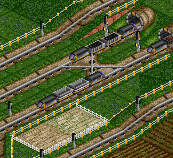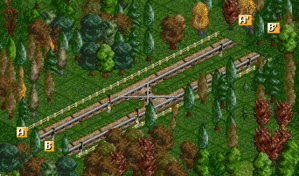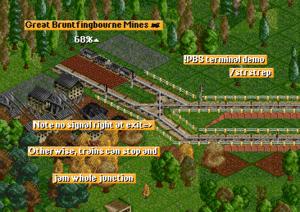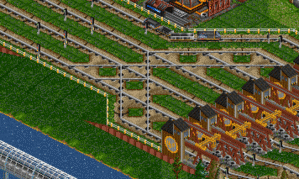Guides:Advanced Signals
From #openttdcoop wiki
| |
| This article or section has been proposed for deletion, with the following comment: "Old, outdated term and we already have a PBS article". Further information may be found on the talk page. |
Contents
Introduction to Advanced Signals
Advanced signals, also known as path-based signals, allow the creation of segments of track that behave much differently than was possible before. As such, here is a tutorial to the proper use of this type of signals. Although advanced signals are very powerful, their misuse can lead to jammed networks. Even using advanced signals the way you would use regular signals is incorrect.
What Advanced Signals Are
Advanced signals cause trains to reserve a path through the block before entering. As long as their reserved paths do not intersect, multiple trains can enter a block with advanced signals at the same time. This can lead to much more compact signaling than was possible, while maintaining efficiency.
What Advanced Signals Are Not
Advanced signals are not an excuse for you to join before split, or for you to join during split, as is very easy to do with their basic structure. Always remember that the principle of track management is to join tracks after splitting.
Never place a regular signal or an advanced signal facing the same direction at the exit of an advanced signal block. Trains can wait at any signal facing them, blocking the whole signal area. You must leave a gap of the train length after any advanced signal block.
Track Switchover
The simplest use of advanced signals is to create a track switchover, allowing trains coming from two inputs to leave at either of two outputs.
In the example above, trains entering at either A or B can pass to either exit, A' or B'. A train can pass from A to A' at the same time that another train is passing from B to B'. However, if a train is moving from A to B' or from B to A', any train on the other track must wait. This leads to the most important consideration of this switchover: only use it if almost all the trains will proceed straight through without switching tracks. As always, leave a gap at the end of the block to allow trains to clear the intersection.
Terminus Station
One nice use of advanced signals is to create a slightly more efficient terminus station. In some circumstances trains can enter and exit at the same time. It is a marginal improvement over the standard presignaled terminus, but an improvement nonetheless. See below for the proper implementation.
Multiple-input Ro-Ro Stations
Another application of advanced signals is to design a quick-and-dirty multiple-input station. Simply drop one-way advanced signals at the front of each entrance to the tracks, and run criss-cross tracks to each station platform. Please note that this is no replacement for a properly designed and implemented solution like a decent mix-o. Efforts to use advanced signals in a mix-o station are still under development.



